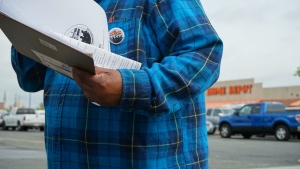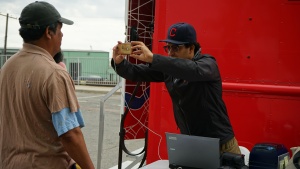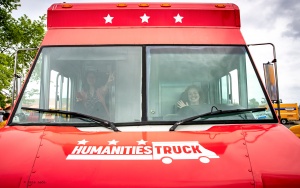This Spring, the Humanities Truck has been on the road with an exhibit featuring day laborers as photographers of their own everyday lives. The exhibit, Invisible Hands: Jornaleros Manos Invisibles: Day laborers, was inaugurated at the Katzen Museum on September, 2016 and was organized as a collaboration between American University and our community partner Trabajadores Unidos de Washington, DC (TUWDC). Since 2013, TUWDC has striven to empower day laborers/jornaleros to know their rights, defend themselves, and advocate for policy change.
The particularity of the jornalero population across the U.S. is that even in plain sight in the cities in which they live, they are invisible to surrounding communities. They are insatiably sought after for their low wages, but they have come to embody all sorts of negative stereotypes. This is one of the biggest battles that Arturo Griffiths, Executive Director of TUWDC struggles against. Photography, in this context, becomes a powerful means to debunk misconceptions and build community. The jornaleros exhibit is a first step in that direction—the day laborers themselves are the photographers of their own everyday lives. Put together, the photos take us from morning to evening and all that happens in between: the unnamed famous corner, the parking lot, the street, the construction site, a home.
The first Humanities Truck stop, on April 19th, was the corner of the Home Depot, a parking lot where every day of the year dozens of men, mostly immigrants from Central America, gather to find work. A few jornaleros approached the Truck timidly to visit the exhibit. Inside, some day laborers recognized themselves or their fellow jornaleros in the photos, in the work they do, the relationships they have established in that space. Over all, they were grateful that their images were on display. They enjoyed the idea of themselves as artists. As a day laborer pointed out, he felt dignified, important to be on display. Outside the Truck, jornaleros shared coffee, received information on steps to take in case of wage theft, (one of the most common problems they face), and immigration issues. They also received TUWDC issued IDs, which for most of the jornaleros, is the only ID available to them. This ID becomes a lifeline in the face of deportation, emergencies with police or migration authorities, incarceration, wage theft, or medical emergencies.
The second stop, on May 22nd, took place at the corner of 14th St and U St NW, in front of the DC Major’s Office of Latino Affairs. Jackie Reyes, Executive Director and some of her staff visited the exhibit. They conducted a Facebook Live and pledged her support for future exhibits with the Humanities Truck.
Future outings with the Humanities Truck are likely, as there are still strategic other corners where the community will benefit from a similar exhibit, such as Mt Pleasant, Columbia Heights, and Langley Park in MD.
This exhibit was curated by jornaleros and AU faculty and students in collaboration with Trabajadores Unidos of Washington, DC. It was sponsored by the Department of World Languages and Cultures, the Studio Art Program, the College or Arts and Sciences, the DC Commission on the Arts and Humanities, and the Humanities Truck.






